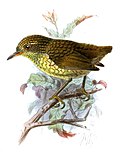| Fluvicola | |
|---|---|
 | |
| Masked water tyrant Fluvicola nengeta | |
| Scientific classification | |
| Kingdom: | Animalia |
| Phylum: | Chordata |
| Class: | Aves |
| Order: | Passeriformes |
| Family: | Tyrannidae |
| Genus: | Fluvicola Swainson, 1827 |
| Type species | |
| Fluvicola cursoria [1] = Lanius nengeta Swainson, 1832 | |
Fluvicola is a genus of birds in the tyrant flycatcher family Tyrannidae.
The genus was introduced by the English naturalist William Swainson in 1827. [2] He designated the type species as the masked water tyrant (Fluvicola nengeta) in 1831. [3] [4] The genus name is derived from a combination of Latin fluvius meaning "river" and -cola meaning "dweller". [5]



